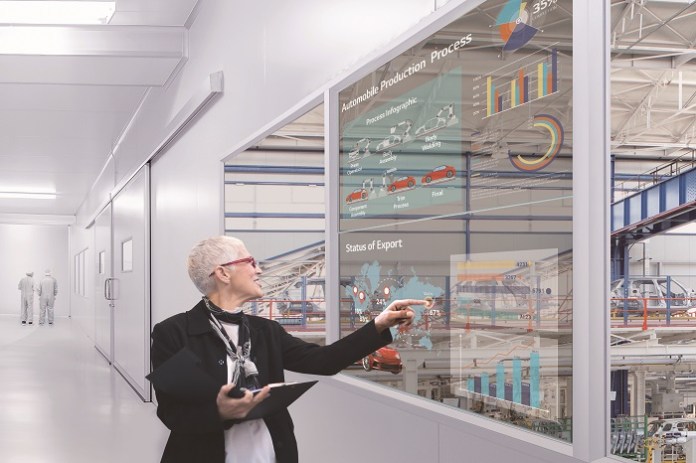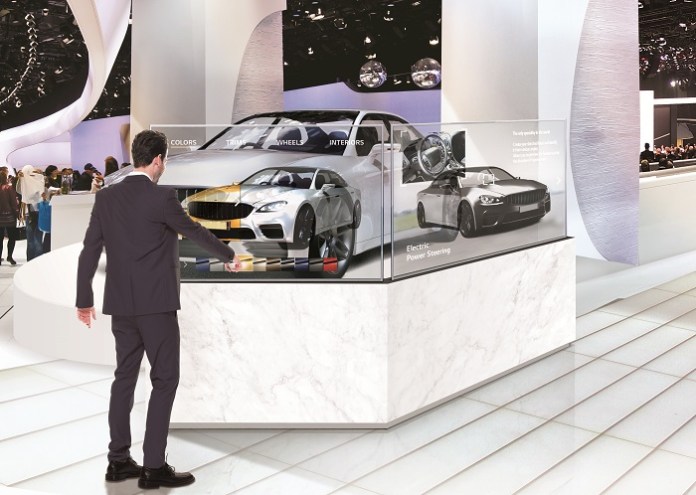Editor’s note: The transparent display market is forecast to grow significantly by 2024, reaching about $4.9 billion, up from $524.7 million in 2018, and growing at a compound annual growth rate of 46.2%, according to market research firm Prescient & Strategic Intelligence. A big portion of this growth is attributed to the increased adoption of transparent OLED displays thanks to several advantages over LCD versions, such as higher image resolution and better viewing angles. In addition, aesthetically-speaking, transparent OLED displays also are more pleasing to the eye, driving adoption in a variety of commercial settings, including retail, hospitality, and even manufacturing. There likely will be an uptick in the use of transparent displays in the healthcare industry as new technologies continue to advance in the medical arena.
One of the leading players in the global transparent display market is LG Electronics Inc. Most recently, the company launched a transparent OLED digital signage display for commercial usage, targeting retail and hospitality sectors. The 55-inch display is available in touch and non-touch versions. Electronic Products spoke with Dan Smith, vice president, business development, at LG Business Solutions USA, about its transparent OLED display with touch technology.

EP: What are transparent OLED Touch displays?
Dan Smith, vice president, business development, at LG Business Solutions USA: LG’s Transparent OLED Touch is a 55-inch digital signage display that uses projected capacitive (P-Cap) film technology for a highly responsive, accurate touch experience, while still allowing significantly greater transparency than conventional transparent LCD displays. The technology provides a user experience that is as close as possible to interacting with bright, colorful content in mid-air. These displays are fully customizable and expandable. They can stand alone, hang on the wall, be put on a stand or mounted.
EP: What are the primary components & key technologies in these types of displays?
Smith: The key features of the Transparent OLED Touch are as follows:
- High transparency – The Transparent OLED touch features 38% transparency, which is significantly higher than traditional LCD displays. High transparency allows the display to seamlessly and naturally blend into its surroundings. These see-through digital displays turn static signage areas into open and interactive spaces.
- Picture Quality – The nature of the OLED’s self-lighting pixels generates a display with rich colors and high contrast even when transparent. The display is capable of up to 400 nits of brightness, depending on application, and a 150,000:1 contrast ratio. Displayed in darker environments, the signage features augmented reality (AR) effects. The content displayed seems life-like, adding another “wow” factor to the viewing experience.
- Robust design – The Transparent OLED Touch display is built with tempered, anti-reflective, shatter-resistant front glass to protect it for commercial use. The display comes semi-assembled so that companies can install it in different structures and spaces depending on the physical environment and desired effect, all while supporting landscape and portrait orientation. No backlight allows for an ultra-slim design, and at its thinnest point, the display is only 7 mm (about a quarter of an inch) thin.
- Touch Solution – The P-Cap touch film offers fast, accurate response to user interaction for a more intuitive, engaging solution. It supports up to 10 touch points at a time.
EP: How does the performance/specs stack up against standard displays?
Smith: When compared to standard LCD displays, the Transparent OLED Touch comes out ahead in virtually every important area. As mentioned earlier, the display is highly transparent. The display is even transparent enough to read fine details or text on objects behind the display. By contrast, conventional LCD displays hover around 10 percent transparency and struggle to make smaller prints easily visible.
In terms of picture quality, OLED does not require external light such as backlight units. It illuminates by using self-lighting pixels. Therefore, OLED colors appear superior compared to LCD and show clear images and natural colors without the help of an artificial light source.
On the design front, the OLED’s tempered glass is a significant element. The tempered glass is safer because it protects the panel from external pressure or impact. The LCD includes no such protection. Additionally, the “touch” element is realized by adding P-Cap sensor film between the glass and panel of the transparent OLED open frame. P-Cap touch type is faster in response than IR type (typically used in LCD touch displays) and has high transmittance for better visibility and a slimmer design. The P-Cap touch type allows for the absolute fastest and most accurate responses — delivering a user interaction that is more intuitive and engaging.
EP: In what types of applications could transparent displays displace standard displays?
Smith: The Transparent OLED Touch is a premium technology product aimed at several high-end areas of application in retail, corporate, and transportation/public spaces. Firstly, retail could mean a luxury product showroom or a traditional store or dealership that sells clothes, jewelry, cars, etc. Transparent OLED signage seamlessly and naturally blends into these affluent surroundings thanks to its high transparency. These see-through digital displays turn basic signage areas into open and interactive spaces.
The same can be said for various corporate venues such as broadcast centers, smart factories, and luxury offices. The benefit here is placing branding where it has never been before. For example, if a factory supervisor is giving a tour to a potential client, on top of showing off any impressive machinery, the supervisor could simply touch a wall display and pull up company facts and figures — seemingly out of thin air. Other public venues such as subways, airports, hotels, museums and more benefit, as well.
While clearly showing objects behind the screen, LG Transparent OLED displays seamlessly overlay information so that viewers can easily see both the object and the relevant information without having to change their view. In an art museum, for example, guests would be able to bring up information on a particular piece with just one touch, without obstructing their view of the art. This fosters an environment where everything is seemingly connected and can be interacted with. Patrons are brought closer than ever thought possible to what’s in front of them. The end result is transformed businesses, delivering experiences that really feel like the way of the future.
Finally, it’s important to note that LG Transparent OLED digital signage is also highly applicable to all of these settings thanks to its design and semi-assembled display, allowing it to be installed in various ways to fit into existing structures and spaces. Transparent OLED signage can be efficiently placed in any potential venue.

EP: Does it open up new market/application opportunities?
Smith: The Transparent OLED Touch technology has opened up a multitude of new market opportunities. Museums and art exhibitions, for example, are not locations typically thought of as typical venues hosting digital signage. However, the LG Transparent OLED Touch’s self-lighting pixels and high transparency provides the perfect overlay for any artifact or art piece. Patrons would be able to read information about the exhibit, essentially in mid-air, without any visual obstruction.
Consider an observatory with a dense, far-reaching landscape and having facts about that location appear over it — just with the touch of a screen. Furthermore, car dealerships are now able to deliver a purchasing experience as advanced as the cars they sell. A digital user interface can be displayed on the transparent screen, allowing potential buyers to peruse an entire car database and customize their ideal right on the screen.
Advertisement
Learn more about LG Display America





